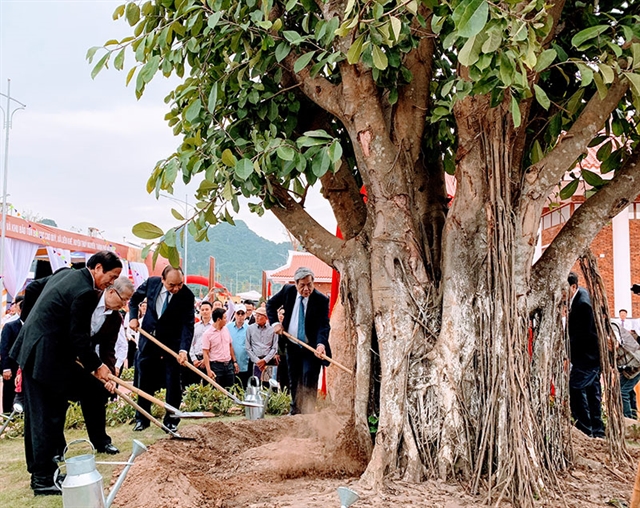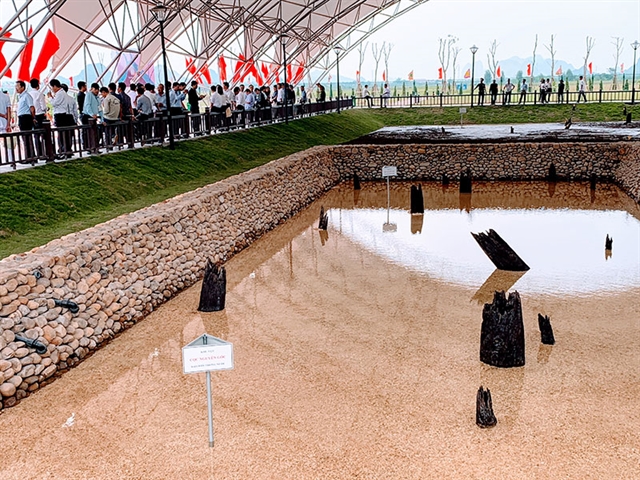HẢI PHÒNG — Prime Minister Nguyễn Xuân Phúc on Wednesday attended the opening ceremony of a new road leading to a 13th-century stake site in Thủy Nguyên District, Hải Phòng.
The event is part of a series of activities to celebrate the city’s 16th Party Congress and the 13th National Central Party Congress.

PM Phúc and his delegation plant a tree at the site. Photo nhandan.com.vn
Archaeologists in 2019 unearthed dozens of pieces of wooden stakes believed to be used as a trap for enemy ships by the navy of Đại Việt (then Việt Nam) in a fight against Youn-Mongol invaders in 1288.
At the end of 2019, city authorities started building a road to the site which covers a total of 3ha.
An entrance gate has been built at the site, with four cement pillars representing Bạch Đằng stakes; as well as surrounding walls, a reception area and exhibition centre covering a total area of 360sq.m. A roof of over 2,000sq.m has been constructed over the site.
The road leading to Cao Quỳ site spans nearly 3.5km, linking National Highway No 10 with the site of the stakes in the communes of Lưu Kỳ and Liên Khê.
The road is properly lit at night and flanked by trees.
In the covered preservation area, 18 wooden stakes are bordered with pebble stones to avoid flooding.
The other stakes are kept intact under the soil and replaced with new ones to help visitors imagine the original shape of the stakes.
The area is decorated with bonsai and fruit trees.
The historic victory on Bạch Đằng River reported in historical books has been proved by traces of wooden stakes on the river bed found in Yên Giang, Đồng Vạn Muối and Đồng Má Ngựa in the northern province of Quảng Ninh.
Traces of the same wooden stakes have been unearthed in Cao Quỳ, Liên Khê Commune, Thủy Nguyên District, Hải Phòng City in 2019.
The wooden samples were tested by radio carbon [carbon-14] dating and proved to be made between 1270 and 1430 AD.
Documents also said in 1288, Hưng Đạo Vương Trần Quốc Tuấn (1228-1300) visited to examine the battle site, train the army to prepare for the fight against the Yuan-Mongol troop.

Wooden stakes preserved at the site. Photo nhandan.com.vn
“The Yuan-Mongol empire was extremely strong. They expanded their territory from the Pacific Ocean to the Mediterranean Sea. They won every battle,” said researcher Vũ Minh Giang, deputy chairman of the Culture Heritage Council.
“In the hope to invade Southeast Asia, they fought Đại Việt three times [in 1257-58; 1284-85 and 1287-88], and lost three times.
"After their loss against Đại Việt in 1288, the empire gradually got weaker and collapsed. The Bạch Đằng victory by the Trần army and people somewhat prevented the empire invading Japan and Southeast Asia,” he said.
Bạch Đằng River, which runs through Quảng Yên Town (northern province of Quảng Ninh) to Thủy Nguyên District (Hải Phòng Province), is a historic river associated with three victories of Vietnamese people against northern invaders, namely the naval battle by Ngô Quyền (897-944) in 938, battle by Lê Hoàn (941-1005) in 981; and battle by Trần Quốc Tuấn in 1288.
During the battles, wooden stakes were widely used as traps for enemy ships. VNS
OVietnam